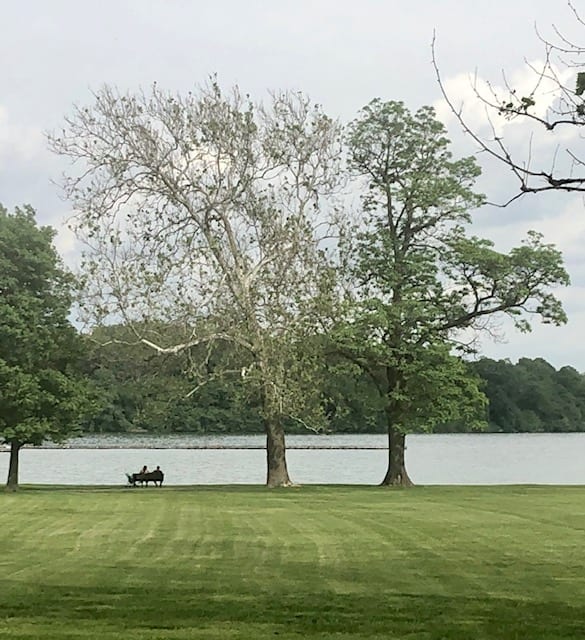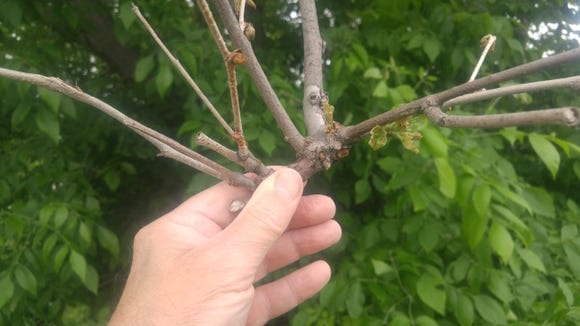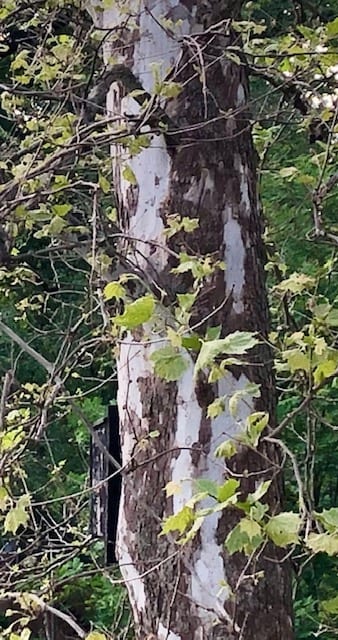Summer has finally arrived! After a long, cold, wet spring, warm temperatures are here. And along with the warm temps come the green trees. All except the Sycamores. Have you noticed that they look dead? They don’t seem to have as many leaves, or any large leaves and some of the leaves have already turned brown and died. The tree on my property didn’t leaf out at all and the buds are dry and brittle. When I started looking around, I saw that all the big, old Sycamores looked the same way. I wondered if this was another disease targeting a specific tree, like the Emerald Ash Borer or Dutch Elm Disease.
That each day I may walk unceasingly on the banks of my water, that my soul may repose on the branches of the trees which I planted, that I may refresh myself under the shadow of my sycamore.–
Egyptian tomb inscription, circa 1400 BC
Are we going to lose all the stately Sycamores?

According to Purdue Extension, the culprit is Sycamore anthracnose. It overwinters in diseased leaves and in cankers on twigs and branches. Spores are produced in the spring and spread by rain. Symptoms can be severe when we have cool, moist spring weather at the time of bud-break and leaf emergence. I feel pretty safe in saying our spring conditions were perfect for it to develop.
The good news is healthy trees generally recover and put out a second flush of leaves once the weather is warmer and drier. I am happy to learn this, as my stately Sycamore is on the west side of the house and provides much needed afternoon shade.
The best management practice to combat Sycamore anthracnose is do nothing! I can handle that. The disease cycle is dependent on cool, moist spring weather so it will run its course by late spring or summer.

Another tell-tale symptom, along with the lack of leaves and dead leaf buds, is the formation of abnormal branching, called witches’ brooms.
Symbolism of a Sycamore Tree
A sycamore tree symbolizes strength, protection, eternity, and divinity. During the Battle of Brandywine in 1777, a 168 year old sycamore tree in Brandywine Battlefield Park, Pennsylvania, sheltered large troops of General Washington. Since then, it became a symbol of protection and hope for the Americans.
Unfortunately, if a tree has been repeatedly defoliated in multiple years, it will lose it’s vigor and be more susceptible to other problems. This is the second year in a row we have had an unusually cool and wet spring so the Sycamores may be under stress.

Large trees add value to your property. Protect your investment by working with a certified arborist to ensure the health of your trees and the value they offer will continue for years to come.

Hi, I’m Debbie Palmer. I received a BS in Horticulture from Purdue University. Here at LMEF, I am responsible for outreach presentations, monitoring the lake and it’s wetlands, project manager for restoration and research projects, and act as a community resource for all things related to the well-being of Lake Maxinkuckee and its surrounding watershed. I completed Indiana Watershed Leadership Academy, volunteer with the Indiana Clean Lakes Program, Hoosier River Watch and Marshall County Lakes and Waters and serve as a Board Member for Indiana Lakes Management Society.


Thank you! We were wondering too!
Thank you for a very informative paper. We have 2 gigantic Sycamores on the beach in the town park which have been there for over 80 years and provide wonderful shade for those who need to get out of the sun. I notice their gigantic leaves are the last to bloom in the spring and first to fall. Now I know why. Thank you
Great explanation. My daughter has a Sycamore tree in her back yard that has been affected and was wondering about it.